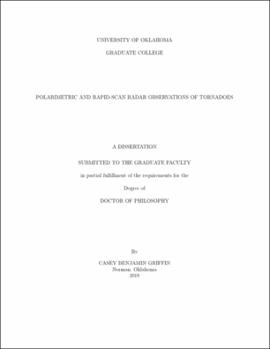| dc.description.abstract | Tornadoes are capable of lofting large pieces of debris that present irregular shapes, near-random orientations, and a wide range of dielectric constants to polarimetric radars. While ties between tornadic debris signature (TDS) characteristics and tornado- and storm-scale kinematic processes have been speculated upon or investigated using photogrammetry and single-Doppler analyses,
little work has been done to relate the three-dimensional wind eld to TDS characteristics and behavior. Additionally a knowledge gap in larger-scale transport and sedimentation of debris exists within the literature. This study utilizes data collected by the University of Oklahoma's Advanced Radar Research Center's OU-PRIME C-band radar as well as KTLX and KOUN WSR-88D S-band radars to study three tornadoes that occurred in Central Oklahoma on 10 May 2010. The relationship between polarimetric and kinematic variables are interrogated revealing an instance where large tornado subvortices were associated with comparatively high reflectivity, low correlation coefficient, and were surrounded by negative differential reflectivity. Comparisons of the polarimetric characteristics of two tornadoes interacting with similar land cover but with different intensities are documented. Also, the storm-scale sedimentation of debris within the supercell is investigated revealing a novel observation of TDS rotation and elongation with height. Additionally, a novel dual-wavelength comparison of debris within the tornado to debris in the near-tornado environment is presented revealing larger dual-wavelength differences in polarimetric variables for debris within the tornado and increasingly similar inner and out debris characteristics as height increases.
While new insight into the behavior of tornadic debris is elucidated in this study, tornadoes themselves evolve on much shorter timescales than what can be resolved by traditional, mechanically steered radars. In order to illustrate the benefit of rapid-scan radars for the study of tornado evolution and to motivate future rapid-scan polarimetric radar observations of tornadoes and debris, high-temporal resolution observations of the 27 May 2015 Canadian, Texas, tornado collected by the Atmospheric Imaging Radar (AIR) are presented. A 10-s resolution time-height investigation of vortex tilt and differential velocity ( V) is presented and illustrates an instance of upward vortex intensification as well as downward tornado decay. Changes in tornado intensity over periods of less than 30 s coincided with rapid changes in tornado diameter. At least two small-scale vortices were observed being shed from the tornado during a brief weakening period. A persistent layer of vortex tilt was observed near the level of free convection, which separated two layers with contrasting modes of tornado decay. Finally, the vertical cross-correlation of vortex intensity reveals that apart from the brief instances of upward vortex intensification and downward decay, tornado intensity was highly correlated throughout the observation period. | en_US |
